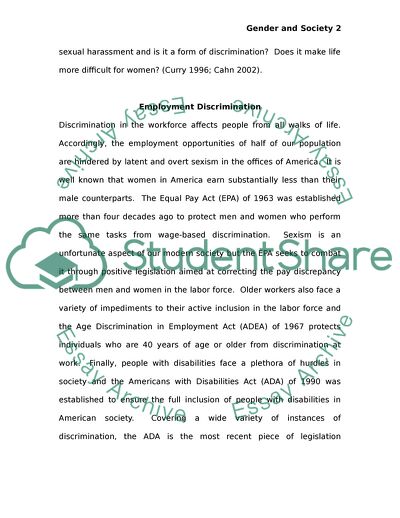
- Home
- Free Samples
- Premium Essays
- Editing Services
- Extra Tools
- Essay Writing Help
- About Us
- Studentshare
- Subjects
- Miscellaneous
- Whether you think it is harder to be a man or woman in today's society. Or discuss whether men or women have more power and why
Whether you think it is harder to be a man or woman in today's society. Or discuss whether men or women have more power and why - Essay Example

- Subject: Miscellaneous
- Type: Essay
- Level: Masters
- Pages: 4 (1000 words)
- Downloads: 0
- Author: jovanifranecki
Extract of sample "Whether you think it is harder to be a man or woman in today's society. Or discuss whether men or women have more power and why"
Discrimination is often based upon pre-held beliefs, judgments and stereotypes about people and groups while Social exclusion refers to the alienation and disenfranchisement of individuals or groups from wider society. Due to the increased diversity of American society today, discrimination is becoming more and more frequent. Prejudice can lead to discrimination and can be described as pre-held beliefs about people or groups with a negative connotation. Accordingly, stereotyping refers to the application of pre-conceived notions – prejudicial thoughts and beliefs – on individuals or groups of people.
We will begin this analysis by asking the following questions: are discrimination and prejudice issues in the workplace? What is sexual harassment and is it a form of discrimination? Does it make life more difficult for women? (Curry 1996; Cahn 2002). Discrimination in the workforce affects people from all walks of life. Accordingly, the employment opportunities of half of our population are hindered by latent and overt sexism in the offices of America. It is well known that women in America earn substantially less than their male counterparts.
The Equal Pay Act (EPA) of 1963 was established more than four decades ago to protect men and women who perform the same tasks from wage-based discrimination. Sexism is an unfortunate aspect of our modern society but the EPA seeks to combat it through positive legislation aimed at correcting the pay discrepancy between men and women in the labor force. Older workers also face a variety of impediments to their active inclusion in the labor force and the Age Discrimination in Employment Act (ADEA) of 1967 protects individuals who are 40 years of age or older from discrimination at work.
Finally, people with disabilities face a plethora of hurdles in society and the Americans with Disabilities Act (ADA) of 1990 was established to ensure the
...Download file to see next pages Read MoreCHECK THESE SAMPLES OF Whether you think it is harder to be a man or woman in today's society. Or discuss whether men or women have more power and why
Addressing Race in America: Declaration of Independence
Pride and Prejudice: A Character Study of Elizabeth Bennet
Pornography and Gender Inequality
Survival by Dorothy Allison
Crisis Pregnancy
Insights of Erich Fromms Escape from Freedom
Is Sexiness an Aesthetic Property
Advertising Text as a Sociocultural Object

- TERMS & CONDITIONS
- PRIVACY POLICY
- COOKIES POLICY